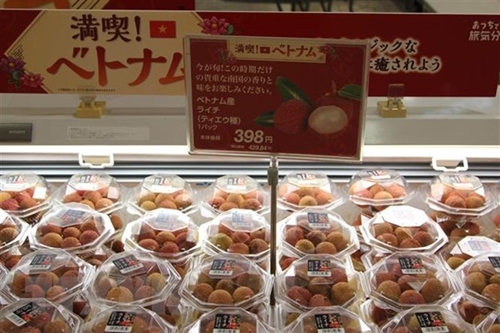Participants said Japan has high demand for agricultural products, seafood and processed foods; while Vietnam has competitive advantages in these areas.
    |
 |
|
Vietnamese lychees are sold at AEON Lake Town supermarket in Saitama, Japan. |
Vietnam and Japan are both members of four bilateral and multilateral free trade agreements – the Vietnam-Japan Economic Partnership Agreement (VJEPA), the Regional Comprehensive Economic Partnership (RCEP), the ASEAN - Japan Comprehensive Economic Partnership (AJCEP) and the Comprehensive and Progressive Agreement for Trans-Pacific Partnership (CPTPP).
In order to penetrate deeper into the Japanese market, Vietnamese enterprises need to research and produce goods suitable to the tastes of Japanese consumers, advised Ta Duc Minh, Trade Counselor at the Vietnam Trade Office in Japan.
The packaging needs to be eye-catching and the labels must provide adequate information, he added.
Duc recommended Vietnamese exporters to pay attention to Japan’s strict requirements for product quality and food safety, as well the verification of their Japanese partners’ profiles.
Quyen Thi Thuy Ha, head of the office’s branch in Osaka, said language is a barrier for Vietnamese businesses which needs to be overcome.
She suggested Vietnamese firms build their profiles in both Japanese and English and launch their own websites to advertise their products.
Japan is currently Vietnam’s 4th largest export partner and 3rd largest import partner. Between 2012 and 2021, import and export turnover increased from 24.7 billion USD to 42.8 billion USD.
Vietnam's agricultural, aquatic and food products are available on the shelves of major supermarket chains in Japan, such as AEON, Donkihote and Itoyokado.
The number of Vietnamese people living in Japan has also increased rapidly in recent years to nearly 500,000 in 2021.
Source: VNA